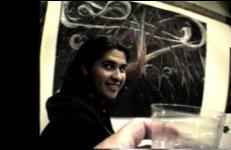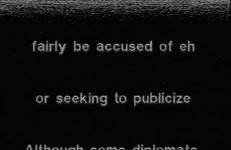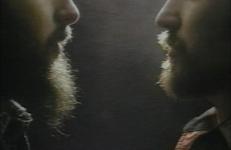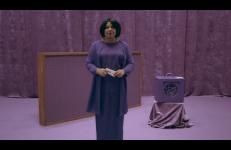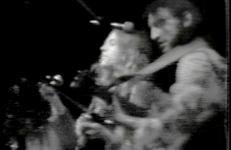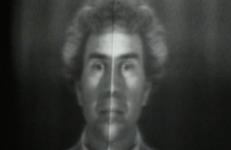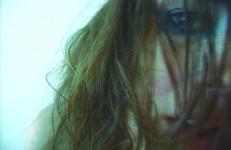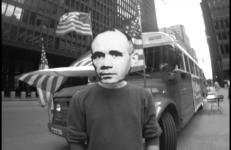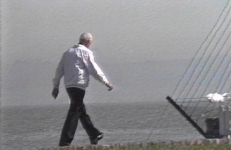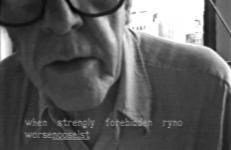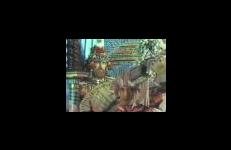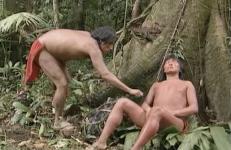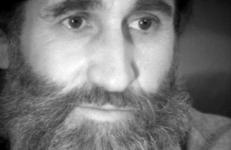"'I am nice. I... am nice. I am... nice," repeats the narrator, in this personal and highly poetic exploration of the construction of self. Mirra favors repetition as the device for reconstructing the stage of development when a child learns its name. Like a bedtime story, the narrator unfolds the tale of a child who identifies herself as a bear. The story becomes increasingly complex as it moves from one voice to two, in which bear and child gradually become distinct entities and the haiku poetry of the child’s identification, 'I, Bear,' is ultimately forsaken for the name Helen.
Performance
I.S.L.A.N.D.S. #1: In Residence Dual trajectories through lush innerscapes propel us into color-saturated action-scenarios where the mission to re-establish identity and sustain communication linkage is never-ending.
I.S.L.A.N.D.S. #2: Operation Big Yellow A useful inanimate object, burdened with excessive psychic residue, is funneled through Half-Life for a complete wipe-down and a few healthy exercises.
Ice is fashioned into a magnifying lens and it is used to start a fire. Created in 1974 and restaged 2004.
This title is also available on Sympathetic Vibrations: The Videoworks of Paul Kos.
A colorful and sinister tale of hypno-therapists delving into the quagmire of UFO abductions, and wallowing in the subconscious muck of their own primal urges. A sprawling saga of consuming passion performed by enrollees of the San Francisco Art Institute under the direction of Professor George Kuchar in Studio 8.
In a fusion of text and image, Rosler re-presents the NBC Nightly News and other broadcast reports to analyze their deceptive syntax and capture the confusion intentionally inserted into the news script. The artist addresses the fallibility of electronic transmission by emphasizing the distortion and absurdities that occur as a result of technical interference. Stressing the fact that there's never a straight story, Rosler asserts her presence in a character-generated text that rolls over the randomly erased images, isolating excerpts from the broadcast sources.
Miller & Shellabarger, their breath made visible by the cold of a refrigerated room, exchange breath with each other.
This title is only available as an excerpt on Suitable Video, Volume 1.
In the Queen City is a series of three videos shot in Buffalo, New York that were produced following an invitation from Hallwalls Contemporary Art Center as part of their Ways In Being Gay festival.
An episode of The Brenda and Glennda Show, hosted by Brenda Sexual and Glennda Orgasm. Production Support Provided by Hallwalls Contemporary Art Center.
In the Queen City is a series of three videos shot in Buffalo, New York that were produced following an invitation from Hallwalls Contemporary Art Center as part of their Ways In Being Gay festival.
An episode of The Brenda and Glennda Show, hosted by Brenda Sexual and Glennda Orgasm. Production Support Provided by Hallwalls Contemporary Art Center.
In the Queen City is a series of three videos shot in Buffalo, New York that were produced following an invitation from Hallwalls Contemporary Art Center as part of their Ways In Being Gay festival.
An episode of The Brenda and Glennda Show, hosted by Brenda Sexual and Glennda Orgasm. Production Support Provided by Hallwalls Contemporary Art Center.
"A chamber drama set in the confines of an apartment’s sun room, this video further explores visual themes and obsessions found in my earlier works and adds in a few new ones for good measure. Earlier motifs seen here are lightbulbs in pendulum movement, tabletop antics with simple household objects, Christo-like fleshy textures, sketchbook pages torn from their binders, book pages, bookshelves, and flowers. I play a vaguely Walter Mitty-ish figure, who imagines himself as a conductor, as Orpheus, and as conflicted characters in a Greta Garbo movie.
Incense Sweaters & Ice is a new feature film inspired by the idea that anything one does while being watched is a performance. The film follows three protagonists — Mrs. Queen Esther Bernetta White, Girl, and WB (“whiteboy”) — as they navigate the dramas of surveillance, moving between looking, being looked at, and remaining unseen. How does the ever-present potential image affect the way we act and the way we see ourselves? By examining how cinema now happens in real time, Syms works between the documented and the live to find the lie.
Shot in December 1969, this video documents a live performance by the Incredible String Band at the Fillmore East, NYC. Beginning with footage of people waiting in line at the doors before the show begins, the video goes on to record the performance itself. Early on, the band experiences some audio problems, before settling down to play. We witness the band talking, tuning their instruments and playing.
Breder used Stavros Deligiorgis’s encyclopedic ability to make associations as an element in this video art and performances, providing a kind of intellectual running commentary in works such as Intertext (1976). He watches a constantly changing mirror image and narrates his experience. His unscripted narration references “the seam” and the intercultural significance of symmetry. Deligiorgis interprets the seam, membrane, or border as an emergent text.
“In Baldessari’s wonderful Inventory, the artist presents to the camera for thirty minutes an accumulation of indiscriminate and not easily legible objects arranged in order of increasing size and accompanied by a deadpan description — only to have the sense of their relative size destroyed by the continual readjustment of the camera [in order to] keep them within the frame. Who can forget Adlai Stevenson’s solemn television demonstration of the ‘conclusive photographic evidence’ of the Cuban missile sites, discernible over the TV screen as only gray blurs?”
In Taiwan, Traditional Taiwanese Opera (gēzǎixì 歌仔戲) and Puppet Plays (bùdàixì 布袋戲) aren’t just performances for human audiences—they are also sacred rituals, that honor and entertain local gods, deities and spirits, particularly during temple fairs. In conversation with eteam, filmmaker S. Leo Chiang, who was born in Taiwan, moved to the U.S. as a teenager and recently returned to Taipei, dives into his childhood memories to rejoice and explore the cultural significance of traditional folk art forms.
The repeatedly distorted, primate behaviour of an (ani)female carrying her baby, reflecting the pain and suffering provoked by the mother/child relationship.
Tapping into cable because of his lousy reception, Mike gets more than he bargained for as he unwittingly becomes trapped in the medium—the “star” of his own cable TV show. Due to an incomprehensible mishap, Mike’s rewired TV now transmits his image to the world; the observer has become the observed. Turning the tables on viewership in a way that reflects the banality of television, Smith touches on identification with television, and the manner in which television re-presents our world back to us.
A queer rewriting of the events surrounding the 1968 National Democratic Convention in Chicago from the point of view of French writer Jean Genet. Along the way Genet will meet, amongst others, Allen Ginsberg, William S. Burroughs, the Yippies, the Black Panther Party and the Chicago police force... Ultimately, the video is about the difficulty of aligning political and sexual desires.
The artist stalks and serenades Joe Dimaggio in her car as he strolls the docks, unaware that McGuire is secretly videotaping his every step.
An extremely rare documentation of a private performance of John Cage, one of the leading avant-garde composers of the 20th century, who created "Writing for the Fifth Time through Finnegan's Wake" using I-Ching chance operation: Chinese fortune telling. Here Cage performs in front of a video camera operated by Takahiko iimura, while he transforms the text of a modern literature classic by James Joyce into Cagian music in three ways: reading, singing and whispering.
Stephen Varble began Journey to the Sun as a series of performances with projected slides in 1978. After becoming notorious for unauthorized costume performances on Soho streets in the mid 1970s, Varble receded from his public persona at this time. Deriving from his identification with his idol, the reclusive actress Greta Garbo, and informed by the spiritual practice of Subud, Varble began writing an allegorical epic about a musician, the Grey Crowned Warbler, who undergoes tribulation and metamorphosis on a journey to transcendence.
Four tales about cannibal monsters narrated and performed by the Waiãpi Indians. “We have made the video,” say the Waiãpi, “to teach people to be more careful with monsters they never heard about. Even a white man can be eaten as he goes into the forest.”
Directed by Vincent Carelli and Dominique Gallois.
Edited by Tutu Nunes.
In Waiãpi with English subtitles.
Four tales about cannibal monsters narrated and performed by the Waiãpi Indians. “We have made the video,” say the Waiãpi, “to teach people to be more careful with monsters they never heard about. Even a white man can be eaten as he goes into the forest.”
Directed by Vincent Carelli and Dominique Gallois.
Edited by Tutu Nunes.
In Waiãpi with English subtitles.
In the second part of the Classics Exposed series, a neurotic scholar (Gibbons) leads a "buggy" ride tour through historic Charleston where, according to the professor, Franz Kafka wrote The Metamorphosis after taking a wrong turn on his way to Hollywood. Live-action with six-legged animation.
This title is also available on Emily Breer: Classics Exposed.
In 1958, Allan Kaprow (1927-2006) published an article on Abstract Expressionism entitled The Legacy of Jackson Pollock in which he suggested the separation of the art-making activity from the art itself. Kaprow’s concept was most famously realized through Happenings, during which the traditional role of artist-creator was replaced by what he called “the social occasion.” In these events, divisions between artist and audience—and between the artwork and the perception of it—were dissolved.







